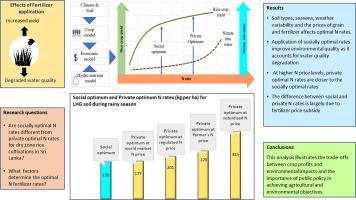Agricultural Systems ( IF 6.1 ) Pub Date : 2023-03-14 , DOI: 10.1016/j.agsy.2023.103628 H. Kanthilanka , T. Ramilan , R.J. Farquharson , J. Weerahewa

|
CONTEXT
The ancient irrigation systems in Sri Lanka, known as village tank cascade systems, were developed to ensure an adequate and sustainable supply of good quality water to communities. However, there is growing concern about health and environmental issues related to the degradation of water quality caused by excessive nitrogen (N) levels from the overuse of chemical fertilizer. Subsidies for chemical fertilizer have encouraged fertilizer use for rice production in Sri Lanka.
OBJECTIVES
The objective was to evaluate the use of N fertilizers for rice production in the Thirappane cascaded tank system and its impact on nitrate water quality. An optimal rate of N use was determined based on private (farm-level) decisions on fertilizer use. However, the private optimal fertilizer rate is not adequate for overall social welfare due to market failures such as incomplete information and the lack of a market to account for the negative impact of fertilizer use on tank water quality. The hypothesis is that the social optimal fertilizer rate is lower than the private optimal rate due to this discrepancy. The study aims to identify the sources of inefficiency in the sub-optimal use of fertilizers from a social perspective.
METHOD
We developed an integrated crop, hydro-nutrient and economic model to analyze fertilizer decisions in the rice production process. The method involved conducting a marginal economic analysis based on simulated yield responses to N fertilizer and prices for inputs and outputs. The analysis was performed for three soil types across the Maha (rainy) and Yala (dry) seasons and for three different weather scenarios within each season.
RESULTS AND CONCLUSIONS
When the negative impact of nitrate contamination on water quality is taken into account, the optimal N fertilizer rate from a social perspective is always lower than the optimal rate determined solely by private economic considerations. These optimal rates varied based on factors such as soil type, season, weather conditions during the growing season, and fertilizer prices. At unregulated, higher, fertilizer prices, the crop yields achieved at the social optimum were only slightly lower than those achieved under the private economic optimum. However, under regulated, lower, fertilizer prices, achieving the social optimum would require a larger reduction in N fertilizer use and result in a greater decrease in crop yields.
SIGNIFICANCE
A systematic analysis that takes into account the social costs can serve as a guide for creating effective policies aimed at enhancing fertilizer decision making.
中文翻译:

斯里兰卡梯级水箱系统中水稻种植的最佳氮肥决策:使用综合作物、水力养分和经济模型的分析
语境
斯里兰卡古老的灌溉系统被称为村庄水箱级联系统,旨在确保为社区提供充足和可持续的优质水源。然而,由于过度使用化肥导致氮 (N) 水平过高导致水质退化,人们越来越关注健康和环境问题。对化肥的补贴鼓励了斯里兰卡水稻生产的化肥使用。
目标
目的是评估在 Thirappane 级联水箱系统中水稻生产中氮肥的使用及其对硝酸盐水质的影响。最佳氮肥使用率是根据私人(农场层面)对肥料使用的决定来确定的。然而,由于信息不完整等市场失灵以及缺乏市场来解释化肥使用对水箱水质的负面影响,私人最优施肥率不足以满足整体社会福利。假设是由于这种差异,社会最优施肥率低于私人最优施肥率。该研究旨在从社会角度确定肥料次优使用效率低下的根源。
方法
我们开发了一个综合作物、水力养分和经济模型来分析水稻生产过程中的肥料决策。该方法涉及根据模拟产量对氮肥的反应以及投入和产出的价格进行边际经济分析。该分析针对Maha(雨季)和Yala(旱季)的三种土壤类型以及每个季节内的三种不同天气情况进行。
结果和结论
当考虑到硝酸盐污染对水质的负面影响时,从社会角度考虑的最优施氮量总是低于仅由私人经济考虑确定的最优施肥量。这些最佳比率因土壤类型、季节、生长季节的天气条件和肥料价格等因素而异。在不受管制的、较高的化肥价格下,在社会最优条件下实现的作物产量仅略低于在私人经济最优条件下实现的作物产量。然而,在受管制的、较低的化肥价格下,实现社会最优将需要更大程度地减少氮肥的使用,并导致作物产量的更大下降。
意义
考虑到社会成本的系统分析可以作为制定旨在加强肥料决策的有效政策的指南。











































 京公网安备 11010802027423号
京公网安备 11010802027423号